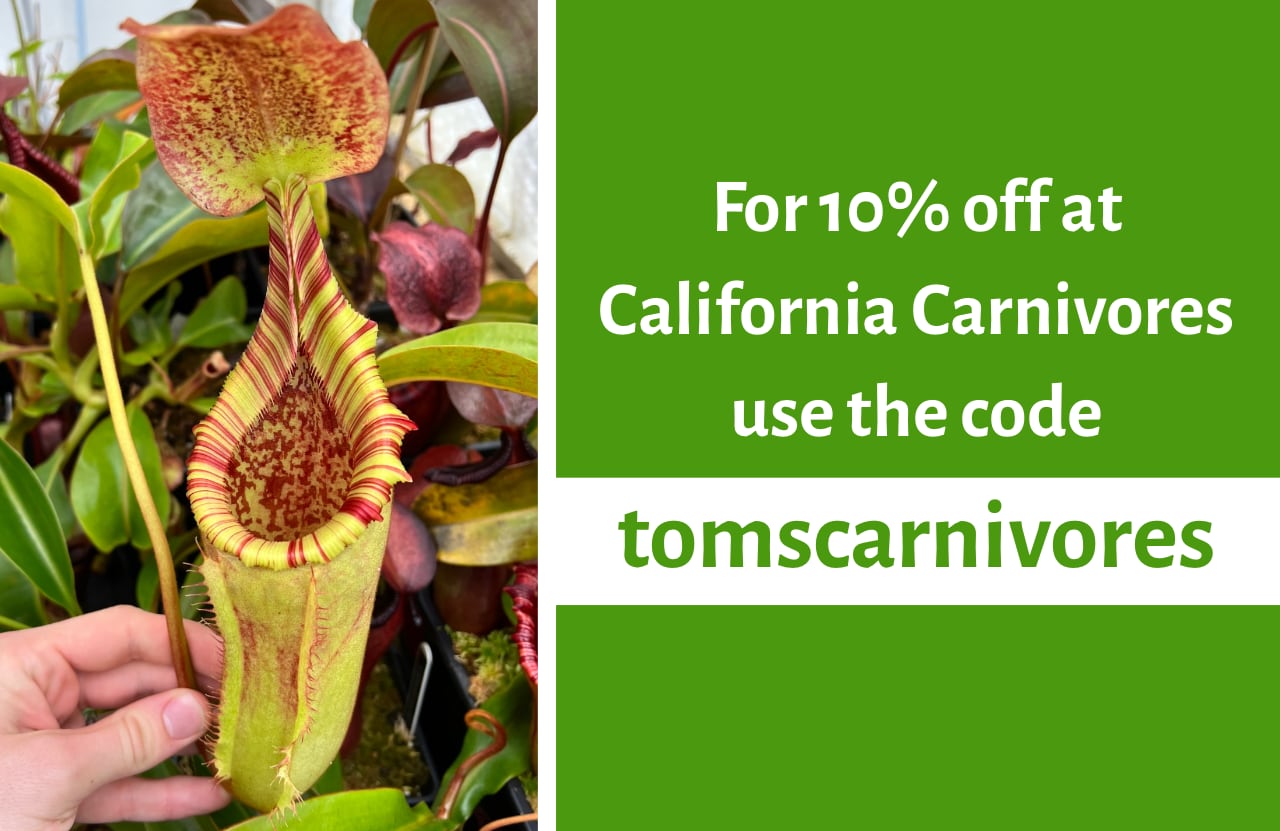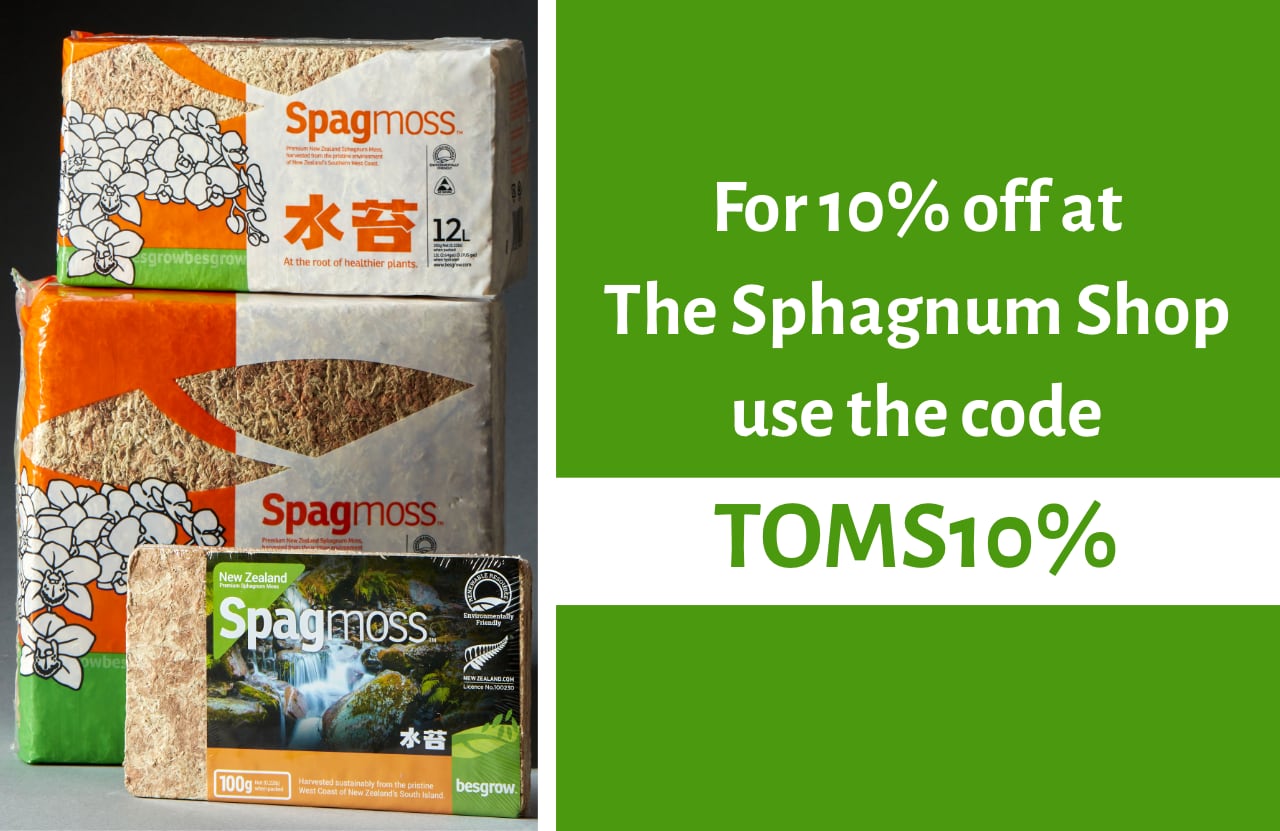| Nepenthes lamii | 2700 | 3520 | New Guinea |
| Nepenthes diatas | 2400 | 2900 | Sumatra |
| Nepenthes angasanensis | 2200 | 2800 | Sumatra |
| Nepenthes densiflora | 1700 | 3200 | Sumatra |
| Nepenthes singalana | 2000 | 2900 | Sumatra |
| Nepenthes macrophylla | 2200 | 2642 | Borneo |
| Nepenthes villosa | 1600 | 3240 | Borneo |
| Nepenthes putaiguneung | 2270 | 2370 | Sumatra |
| Nepenthes lavicola | 2000 | 2600 | Sumatra |
| Nepenthes diabolica | 2200 | 2300 | Sulawesi |
| Nepenthes murudensis | 2000 | 2423 | Borneo |
| Nepenthes aristolochioides | 1800 | 2500 | Sumatra |
| Nepenthes dubia | 1600 | 2700 | Sumatra |
| Nepenthes edwardsiana | 1600 | 2700 | Borneo |
| Nepenthes talangensis | 1800 | 2500 | Sumatra |
| Nepenthes lowii | 1650 | 2600 | Borneo |
| Nepenthes maryae | 2050 | 2150 | Sulawesi |
| Nepenthes nigra | 1500 | 2700 | Sulawesi |
| Nepenthes rajah | 1500 | 2650 | Borneo |
| Nepenthes inermis | 1500 | 2600 | Sumatra |
| Nepenthes muluensis | 1700 | 2400 | Borneo |
| Nepenthes monticola | 1400 | 2620 | New Guinea |
| Nepenthes flava | 1800 | 2200 | Sumatra |
| Nepenthes spathulata | 1100 | 2900 | Java, Sumatra |
| Nepenthes hamata | 1400 | 2500 | Sulawesi |
| Nepenthes jacquelineae | 1700 | 2200 | Sumatra |
| Nepenthes jamban | 1800 | 2100 | Sumatra |
| Nepenthes kitanglad | 1800 | 2100 | Philippines |
| Nepenthes mikei | 1100 | 2800 | Sumatra |
| Nepenthes sumagaya | 1600 | 2247 | Philippines |
| Nepenthes lingulata | 1700 | 2100 | Sumatra |
| Nepenthes ovata | 1700 | 2100 | Sumatra |
| Nepenthes alba | 1600 | 2187 | Peninsular Malaysia |
| Nepenthes mantalingajanensis | 1700 | 2085 | Philippines |
| Nepenthes bongso | 1000 | 2700 | Sumatra |
| Nepenthes glabrata | 1600 | 2100 | Sulawesi |
| Nepenthes pectinata | 950 | 2750 | Sumatra |
| Nepenthes xiphioides | 1800 | 1900 | Sumatra |
| Nepenthes mollis | 1300 | 2400 | Borneo |
| Nepenthes alzapan | 1750 | 1850 | Philippines |
| Nepenthes izumiae | 1700 | 1900 | Sumatra |
| Nepenthes rhombicaulis | 1600 | 2000 | Sumatra |
| Nepenthes robcantleyi | 1750 | 1850 | Philippines |
| Nepenthes spectabilis | 1400 | 2200 | Sumatra |
| Nepenthes undulatifolia | 1750 | 1850 | Sulawesi |
| Nepenthes fractiflexa | 1400 | 2150 | Borneo |
| Nepenthes copelandii | 1100 | 2400 | Philippines |
| Nepenthes naga | 1500 | 2000 | Sumatra |
| Nepenthes berbulu | 1400 | 2100 | Peninsular Malaysia |
| Nepenthes barcelonae | 1500 | 1905 | Philippines |
| Nepenthes gracillima | 1400 | 2000 | Peninsular Malaysia |
| Nepenthes gymnamphora | 600 | 2800 | Java, Sumatra |
| Nepenthes stenophylla | 800 | 2600 | Borneo |
| Nepenthes gantungensis | 1600 | 1784 | Philippines |
| Nepenthes ceciliae | 1500 | 1880 | Philippines |
| Nepenthes zygon | 1500 | 1875 | Philippines |
| Nepenthes petiolata | 1450 | 1900 | Philippines |
| Nepenthes argentii | 1400 | 1900 | Philippines |
| Nepenthes ephippiata | 1300 | 2000 | Borneo |
| Nepenthes zakriana | 800 | 2500 | Borneo |
| Nepenthes pilosa | 1550 | 1650 | Borneo |
| Nepenthes pitopangii | 1400 | 1800 | Sulawesi |
| Nepenthes nebularum | 1400 | 1800 | Philippines |
| Nepenthes attenboroughii | 1450 | 1726 | Philippines |
| Nepenthes macfarlanei | 1500 | 1657 | Peninsular Malaysia |
| Nepenthes mira | 1550 | 1605 | Philippines |
| Nepenthes appendiculata | 1450 | 1700 | Borneo |
| Nepenthes burkei | 1100 | 2000 | Philippines |
| Nepenthes pulchra | 1300 | 1800 | Philippines |
| Nepenthes sericea | 900 | 2150 | Peninsular Malaysia |
| Nepenthes boschiana | 1200 | 1800 | Borneo |
| Nepenthes burbidgeae | 1200 | 1800 | Borneo |
| Nepenthes eymae | 1000 | 2000 | Sulawesi |
| Nepenthes ventricosa | 1000 | 2000 | Philippines |
| Nepenthes fusca | 1400 | 1600 | Borneo |
| Nepenthes tentaculata | 400 | 2550 | Borneo, Sulawesi |
| Nepenthes adrianii | 950 | 2000 | Java |
| Nepenthes klossii | 930 | 2000 | New Guinea |
| Nepenthes tboli | 1413 | 1513 | Philippines |
| Nepenthes paniculata | 1410 | 1510 | New Guinea |
| Nepenthes chaniana | 1100 | 1800 | Borneo |
| Nepenthes ramispina | 900 | 2000 | Peninsular Malaysia |
| Nepenthes taminii | 900 | 1950 | Sumatra |
| Nepenthes glandulifera | 1100 | 1700 | Borneo |
| Nepenthes hamiguitanensis | 1200 | 1600 | Philippines |
| Nepenthes leonardoi | 1300 | 1490 | Philippines |
| Nepenthes pantaronensis | 1340 | 1440 | Philippines |
| Nepenthes sibuyanensis | 1250 | 1500 | Philippines |
| Nepenthes micramphora | 1100 | 1635 | Philippines |
| Nepenthes ulukaliana | 900 | 1800 | Peninsular Malaysia |
| Nepenthes minima | 1000 | 1700 | Sulawesi |
| Nepenthes maxima | 40 | 2600 | Maluku Islands, New Guinea, Sulawesi |
| Nepenthes justinae | 1000 | 1620 | Philippines |
| Nepenthes rigidifolia | 1000 | 1600 | Sumatra |
| Nepenthes negros | 1250 | 1350 | Philippines |
| Nepenthes peltata | 865 | 1635 | Philippines |
| Nepenthes vogelii | 1000 | 1500 | Borneo |
| Nepenthes deaniana | 1180 | 1296 | Philippines |
| Nepenthes junghuhnii | 1170 | 1270 | Sumatra |
| Nepenthes aenigma | 1150 | 1250 | Philippines |
| Nepenthes pudica | 1100 | 1300 | Borneo |
| Nepenthes longiptera | 750 | 1600 | Sumatra |
| Nepenthes palawanensis | 1100 | 1236 | Philippines |
| Nepenthes platychila | 900 | 1400 | Borneo |
| Nepenthes alata | 550 | 1650 | Philippines |
| Nepenthes dactylifera | 300 | 1900 | Borneo |
| Nepenthes reinwardtiana | 0 | 2200 | Borneo, Sumatra |
| Nepenthes tenuis | 1000 | 1200 | Sumatra |
| Nepenthes tobaica | 380 | 1800 | Sumatra |
| Nepenthes ampullaria | 0 | 2100 | Borneo, Maluku Islands, New Guinea, Peninsular Malaysia, Singapore, Sumatra, Thailand |
| Nepenthes sanguinea | 300 | 1800 | Peninsular Malaysia, Thailand |
| Nepenthes latiffiana | 1000 | 1100 | Peninsular Malaysia |
| Nepenthes ramos | 670 | 1400 | Philippines |
| Nepenthes cabanae | 1000 | 1050 | Philippines |
| Nepenthes cornuta | 950 | 1050 | Philippines |
| Nepenthes epiphytica | 950 | 1050 | Borneo |
| Nepenthes faizaliana | 400 | 1600 | Borneo |
| Nepenthes khasiana | 500 | 1500 | India |
| Nepenthes surigaoensis | 800 | 1200 | Philippines |
| Nepenthes talaandig | 950 | 1050 | Philippines |
| Nepenthes harauensis | 700 | 1300 | Sumatra |
| Nepenthes malimumuensis | 970 | 1020 | Philippines |
| Nepenthes manobo | 970 | 1020 | Philippines |
| Nepenthes bokorensis | 800 | 1080 | Cambodia |
| Nepenthes domei | 850 | 1000 | Peninsular Malaysia |
| Nepenthes adnata | 600 | 1200 | Sumatra |
| Nepenthes leyte | 850 | 950 | Philippines |
| Nepenthes malayensis | 800 | 1000 | Peninsular Malaysia |
| Nepenthes erucoides | 800 | 929 | Philippines |
| Nepenthes eustachya | 0 | 1600 | Sumatra |
| Nepenthes veitchii | 0 | 1600 | Borneo |
| Nepenthes cid | 720 | 820 | Philippines |
| Nepenthes saranganiensis | 700 | 800 | Philippines |
| Nepenthes benstonei | 150 | 1350 | Peninsular Malaysia |
| Nepenthes macrovulgaris | 300 | 1200 | Borneo |
| Nepenthes mapuluensis | 700 | 800 | Borneo |
| Nepenthes mirabilis | 0 | 1500 | Australia, Borneo, Cambodia, Java, Laos, Maluku Islands, New Guinea, Peninsular Malaysia, Philippines, Sulawesi, Sumatra, Thailand, Vietnam & more |
| Nepenthes smilesii | 0 | 1500 | Cambodia, Laos, Thailand, Vietnam |
| Nepenthes truncata | 0 | 1500 | Philippines |
| Nepenthes bracteosa | 710 | 760 | Thailand |
| Nepenthes weda | 415 | 1014 | Maluku Islands |
| Nepenthes clipeata | 600 | 800 | Borneo |
| Nepenthes holdenii | 600 | 800 | Cambodia |
| Nepenthes longifolia | 300 | 1100 | Sumatra |
| Nepenthes mindanaoensis | 0 | 1400 | Philippines |
| Nepenthes neoguineensis | 0 | 1400 | New Guinea |
| Nepenthes armin | 500 | 850 | Philippines |
| Nepenthes abgracilis | 620 | 720 | Philippines |
| Nepenthes hirsuta | 200 | 1100 | Borneo |
| Nepenthes krabiensis | 600 | 700 | Thailand |
| Nepenthes papuana | 0 | 1300 | New Guinea |
| Nepenthes graciliflora | 0 | 1280 | Philippines |
| Nepenthes rafflesiana | 0 | 1200 | Borneo, Peninsular Malaysia, Singapore, Sumatra |
| Nepenthes halmahera | 0 | 1200 | Maluku Islands |
| Nepenthes albomarginata | 0 | 1100 | Borneo, Peninsular Malaysia, Sumatra |
| Nepenthes gracilis | 0 | 1100 | Borneo, Cambodia, Peninsular Malaysia, Singapore, Sulawesi, Sumatra, Thailand |
| Nepenthes merrilliana | 0 | 1100 | Philippines |
| Nepenthes pervillei | 350 | 750 | Seychelles |
| Nepenthes thai | 500 | 600 | Thailand |
| Nepenthes rosea | 450 | 520 | Thailand |
| Nepenthes chang | 300 | 600 | Thailand |
| Nepenthes hispida | 100 | 800 | Borneo |
| Nepenthes kerrii | 400 | 500 | Thailand |
| Nepenthes insignis | 0 | 850 | New Guinea |
| Nepenthes vieillardii | 0 | 850 | New Caledonia |
| Nepenthes beccariana | 0 | 800 | Sumatra |
| Nepenthes bellii | 0 | 800 | Philippines |
| Nepenthes extincta | 350 | 450 | Philippines |
| Nepenthes sumatrana | 0 | 800 | Sumatra |
| Nepenthes bicalcarata | 0 | 700 | Borneo |
| Nepenthes distillatoria | 0 | 700 | Sri Lanka |
| Nepenthes hirtella | 325 | 375 | Thailand |
| Nepenthes kampotiana | 0 | 600 | Cambodia, Thailand, Vietnam |
| Nepenthes philippinensis | 0 | 600 | Philippines |
| Nepenthes samar | 0 | 600 | Philippines |
| Nepenthes alfedoi | 160 | 345 | Philippines |
| Nepenthes madagascariensis | 0 | 500 | Madagascar |
| Nepenthes northiana | 0 | 500 | Borneo |
| Nepenthes tomoriana | 0 | 500 | Sulawesi |
| Nepenthes campanulata | 100 | 300 | Borneo, Philippines |
| Nepenthes masoalensis | 0 | 400 | Madagascar |
| Nepenthes ultra | 0 | 400 | Philippines |
| Nepenthes danseri | 0 | 320 | Maluku Islands |
| Nepenthes hemsleyana | 0 | 200 | Borneo |
| Nepenthes suratensis | 0 | 200 | Thailand |
| Nepenthes thorelii | 0 | 200 | Vietnam |
| Nepenthes rowaniae | 0 | 80 | Australia |
| Nepenthes tenax | 0 | 80 | Australia |
| Nepenthes treubiana | 0 | 80 | New Guinea |
| Nepenthes viridis | 0 | 50 | Philippines |
| Nepenthes parvula | 0 | 50 | Australia |
| Nepenthes abalata | 0 | 50 | Philippines |
| Nepenthes andamana | 0 | 50 | Thailand |
| Nepenthes kongkandana | 0 | 50 | Thailand |
| Nepenthes biak | 0 | 50 | New Guinea |
| Nepenthes orbiculata | 0 | 50 | Thailand |
| Nepenthes tayninhensis | 0 | 50 | Vietnam |
| Nepenthes misoolensis | 0 | 50 | New Guinea |



